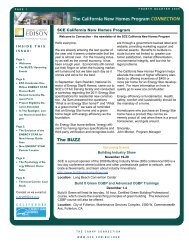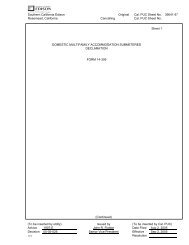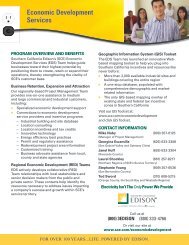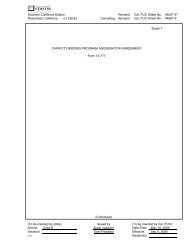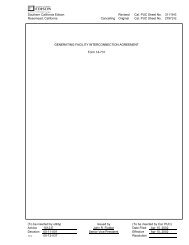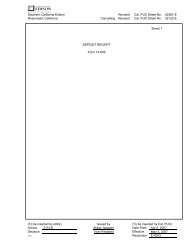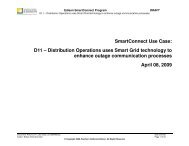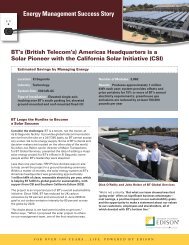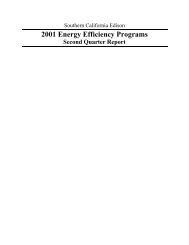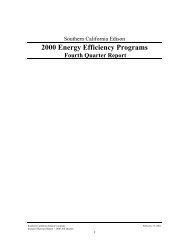Dear Customer: Your inquiry about electric and magnetic fields is ...
Dear Customer: Your inquiry about electric and magnetic fields is ...
Dear Customer: Your inquiry about electric and magnetic fields is ...
You also want an ePaper? Increase the reach of your titles
YUMPU automatically turns print PDFs into web optimized ePapers that Google loves.
WHO | Electro<strong>magnetic</strong> <strong>fields</strong> <strong>and</strong> public health<br />
There are establ<strong>is</strong>hed biological effects from acute exposure at high levels (well above 100 µT) that are explained by<br />
recognized biophysical mechan<strong>is</strong>ms. External ELF <strong>magnetic</strong> <strong>fields</strong> induce <strong>electric</strong> <strong>fields</strong> <strong>and</strong> currents in the body<br />
which, at very high field strengths, cause nerve <strong>and</strong> muscle stimulation <strong>and</strong> changes in nerve cell excitability in the<br />
central nervous system.<br />
Potential long-term effects<br />
Much of the scientific research examining long-term r<strong>is</strong>ks from ELF <strong>magnetic</strong> field exposure has focused on childhood<br />
leukaemia. In 2002, IARC publ<strong>is</strong>hed a monograph classifying ELF <strong>magnetic</strong> <strong>fields</strong> as "possibly carcinogenic to<br />
humans". Th<strong>is</strong> classification <strong>is</strong> used to denote an agent for which there <strong>is</strong> limited evidence of carcinogenicity in humans<br />
<strong>and</strong> less than sufficient evidence for carcinogenicity in experimental animals (other examples include coffee <strong>and</strong><br />
welding fumes). Th<strong>is</strong> classification was based on pooled analyses of epidemiological studies demonstrating a cons<strong>is</strong>tent<br />
pattern of a two-fold increase in childhood leukaemia associated with average exposure to residential power-frequency<br />
<strong>magnetic</strong> field above 0.3 to 0.4 µT. The Task Group concluded that additional studies since then do not alter the status<br />
of th<strong>is</strong> classification.<br />
However, the epidemiological evidence <strong>is</strong> weakened by methodological problems, such as potential selection bias. In<br />
addition, there are no accepted biophysical mechan<strong>is</strong>ms that would suggest that low-level exposures are involved in<br />
cancer development. Thus, if there were any effects from exposures to these low-level <strong>fields</strong>, it would have to be<br />
through a biological mechan<strong>is</strong>m that <strong>is</strong> as yet unknown. Additionally, animal studies have been largely negative. Thus,<br />
on balance, the evidence related to childhood leukaemia <strong>is</strong> not strong enough to be considered causal.<br />
Childhood leukaemia <strong>is</strong> a comparatively rare d<strong>is</strong>ease with a total annual number of new cases estimated to be 49,000<br />
worldwide in 2000. Average <strong>magnetic</strong> field exposures above 0.3 μT in homes are rare: it <strong>is</strong> estimated that only between<br />
1% <strong>and</strong> 4% of children live in such conditions. If the association between <strong>magnetic</strong> <strong>fields</strong> <strong>and</strong> childhood leukaemia <strong>is</strong><br />
causal, the number of cases worldwide that might be attributable to <strong>magnetic</strong> field exposure <strong>is</strong> estimated to range from<br />
100 to 2400 cases per year, based on values for the year 2000, representing 0.2 to 4.95% of the total incidence for that<br />
year. Thus, if ELF <strong>magnetic</strong> <strong>fields</strong> actually do increase the r<strong>is</strong>k of the d<strong>is</strong>ease, when considered in a global context, the<br />
impact on public health of ELF EMF exposure would be limited.<br />
A number of other adverse health effects have been studied for possible association with ELF <strong>magnetic</strong> field exposure.<br />
These include other childhood cancers, cancers in adults, depression, suicide, cardiovascular d<strong>is</strong>orders, reproductive<br />
dysfunction, developmental d<strong>is</strong>orders, immunological modifications, neurobehavioural effects <strong>and</strong> neurodegenerative<br />
d<strong>is</strong>ease. The WHO Task Group concluded that scientific evidence supporting an association between ELF <strong>magnetic</strong><br />
field exposure <strong>and</strong> all of these health effects <strong>is</strong> much weaker than for childhood leukaemia. In some instances (i.e. for<br />
cardiovascular d<strong>is</strong>ease or breast cancer) the evidence suggests that these <strong>fields</strong> do not cause them.<br />
International exposure guidelines<br />
Health effects related to short-term, high-level exposure have been establ<strong>is</strong>hed <strong>and</strong> form the bas<strong>is</strong> of two international<br />
exposure limit guidelines (ICNIRP, 1998; IEEE, 2002). At present, these bodies consider the scientific evidence related<br />
to possible health effects from long-term, low-level exposure to ELF <strong>fields</strong> insufficient to justify lowering these<br />
quantitative exposure limits.<br />
WHO's guidance<br />
Page 2 of 3<br />
For high-level short-term exposures to EMF, adverse health effects have been scientifically establ<strong>is</strong>hed (ICNIRP,<br />
2003). International exposure guidelines designed to protect workers <strong>and</strong> the public from these effects should be<br />
adopted by policy makers. EMF protection programs should include exposure measurements from sources where<br />
exposures might be expected to exceed limit values.<br />
Regarding long-term effects, given the weakness of the evidence for a link between exposure to ELF <strong>magnetic</strong> <strong>fields</strong><br />
<strong>and</strong> childhood leukaemia, the benefits of exposure reduction on health are unclear. In view of th<strong>is</strong> situation, the<br />
following recommendations are given:<br />
Government <strong>and</strong> industry should monitor science <strong>and</strong> promote research programmes to further reduce the<br />
uncertainty of the scientific evidence on the health effects of ELF field exposure. Through the ELF r<strong>is</strong>k<br />
assessment process, gaps in knowledge have been identified <strong>and</strong> these form the bas<strong>is</strong> of a new research agenda.<br />
http://www.who.int/mediacentre/factsheets/fs322/en/print.html<br />
9/29/2008



